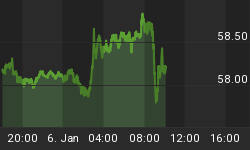The U.S. economy has become a "real estate economy," as someone has recently observed. The fortunes of millions of individual Americans are tied up in home and property values and for most Americans this represents their biggest financial asset. Soaring real estate prices have now taken center stage and have eclipsed other markets, including equities for the time being. The focus of bulls and bears alike is on this vitally important economic sector, and a collapse in real estate prices would surely destroy the U.S. economy. A strong, vibrant real estate market on the other hand would serve to help keep the economy buoyant in the foreseeable future.
One of the greatest market technicians of modern times is undoubtedly P.Q. Wall. P.Q. has developed many fascinating and reliable techniques for predicting future price movements over the years. I remember in particular back in the 1990s when P.Q. used to talk about his "Magic Mid-Point" theory of price forecasting. He used this technique to forecast a major upside objective for the Dow Jones Industrial Average back in the late '90s stock market boom. He came mighty close, I might add, although he had more than one possible upside objective for the Dow since the long-term Dow chart was admittedly tough to nail down a specific mid-point.
This is known, in Wall's theory of technical analysis, as "price equilibrium studies." As for the mechanics of this theory, Wall surmised that prices of stocks and indices adhered to the Fibonacci principle of 50%. Simply stated, price equilibrium studies is a form of market analysis whereby a chart is divided into several equidistant lines of support and resistance (which Wall calls "floors" and "ceilings"). If, for example, a stock can make it to a specific price level that has never been reached before, and then after pulling back doesn't violate this price level, it likely represents an established mid-point, meaning that the half-way point has been reached and the stock still has halfway to travel before it reaches a major top. His theory of equidistant lines is based on the observation that prices tend to move in increments that parallel previous movements by nearly the same amount, especially meaningful movements.
The key to isolating equidistant lines on the chart is to look for what Wall described as "seldom crossed lines." These are price levels that have rarely been crossed by the price line -- usually no more than once in the stock's trading history. Isolating these seldom crossed price areas is not as difficult as it may seems since in most cases a stock has crossed almost every price in its trading history more than once.
Here is how a long-term chart of the Dow looks retrospectively with the so-called "Magic Mid-Point" line drawn at the 6,000 level, which was reached in 1996. You can see that very little, if any, congestion shows up at the 6,000 area and in fact it appears to be the level of least resistance during the Dow's multi-decade climb up to that point and therefore qualified as a seldom crossed line.

So what did this forecast? Based on Wall's Magic Mid-Point theory it projected a major upside target of approximately 12,000 before a major top was in place. Sure enough, this was very close to where the Dow met with ultimate resistance in late '99/early '00.
Of course, there can be multiple mid-points along the way of a long-term bull market. There isn't just one mid-point, but usually several. However, in the long-term scheme of things one price level in particular always stands out as being key, and clearly for the Dow it was the 6,000 level.
Now let's apply this same forecasting technique to the U.S. real estate sector. The Morgan Stanley REIT Index (RMS) clearly has a "Magic Mid-Point" at the 500 level. You can see this plainly in the long-term weekly chart shown below. The 500 level is not only a nice round number with psychological significance, it's also the only level in the chart with no perceptible congestion. If you were to zoom in on the 500 level in this chart back when RMS first hit this level in 2003, you'd see that after making it above 500 with no trouble, the subsequent pullback was brief and shallow and never violated the 500 level. In other words, RMS established support above 500 thereby cementing this level as the mid-point. The forecasting objective is obvious: RMS is headed to at least the 1,000 level before its next major peak.

The implications of this technical study on U.S. real estate equity prices is that we haven't seen the top yet and that the real estate boom will continue into the foreseeable future. Year 2005 could be a vibrant for housing and commercial property prices. This would be in keeping for the generally optimistic outlook for 2005.
















